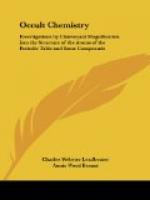Above the tetrahedron is a balloon-shaped figure, apparently drawn into shape by the attraction of the tetrahedron. The body below the tetrahedron looks like a coil of rope, and contains fifteen atoms; they are arranged on a slanting disk in a flat ring, and the force goes in at the top of one atom, and out of the bottom of it into the top of the next, and so on, making a closed circuit. The two little spheres, each containing a triplet, are like fill-up paragraphs to a compositor—they seem to be kept standing and popped in where wanted. The sphere marked x is a proto-compound, the balloon when set free.
As was noted under gold (p. 41), sixteen occultum bodies, re-arranged, make up the connecting rod in gold:—
OCCULTUM: Tetrahedron 24
Balloon
9
Triplets
6
Rope-circle
15
——
Total
54
——
Atomic
weight Not known
Number
weight 54/18 3
DISSOCIATION OF ATOMS.
Before proceeding to the study of other chemical atoms, as to their general internal arrangements, it is desirable to follow out, in those already shown, the way in which these atoms break up into simpler forms, yielding successively what we have called proto-, meta-, and hyper-compounds. It is naturally easier to follow these in the simpler atoms than in the more complex, and if the earlier dissociations are shown, the latter can be more readily and more intelligibly described.
The first thing that happens on removing a gaseous atom from its “hole” (see pp. 21 to 23) or encircling “wall,” is that the contained bodies are set free, and, evidently released from tremendous pressure, assume spherical or ovoid forms, the atoms within each re-arranging themselves, more or less, within the new “hole” or “wall.” The figures are, of course, three-dimensional, and often remind one of crystals; tetrahedral, octagonal, and other like forms being of constant occurrence. In the diagrams of the proto-compounds, the constituent atoms are shown by dots. In the diagrams of the meta-compounds the dot becomes a heart, in order to show the resultants of the lines of force. In the diagrams of the hyper-compounds the same plan is followed. The letters a, b, c, &c., enable the student to follow the breaking up of each group through its successive stages.
HYDROGEN (Plate V, 1).
[Illustration]
The six bodies contained in the gaseous atom instantaneously re-arrange themselves within two spheres; the two linear triplets unite with one triangular triplet, holding to each other relative positions which, if connected by three right lines, would form a triangle with a triplet at each angle; the remaining three triangular triplets similarly arrange themselves in the second sphere. These form the proto-compounds of hydrogen.




